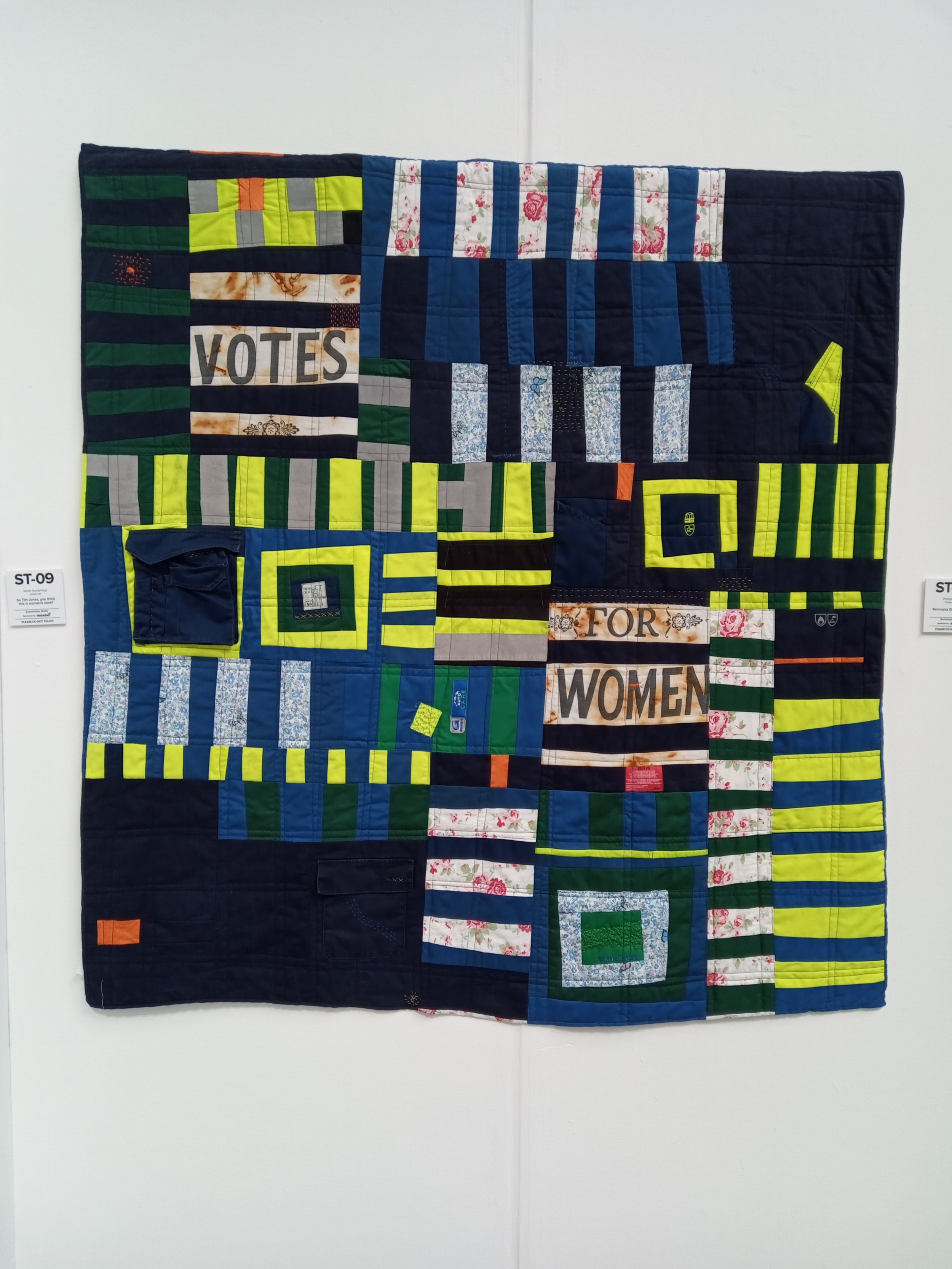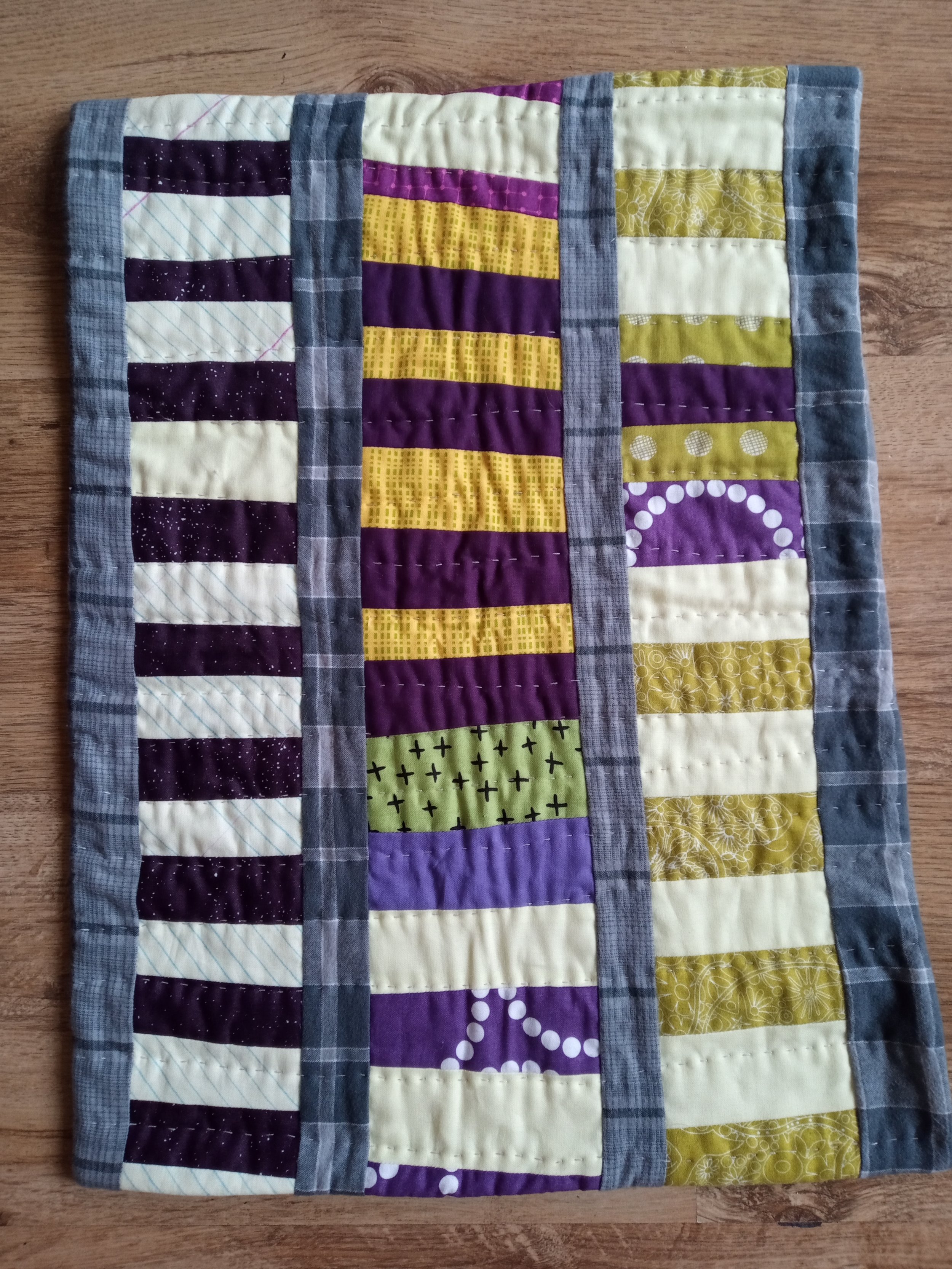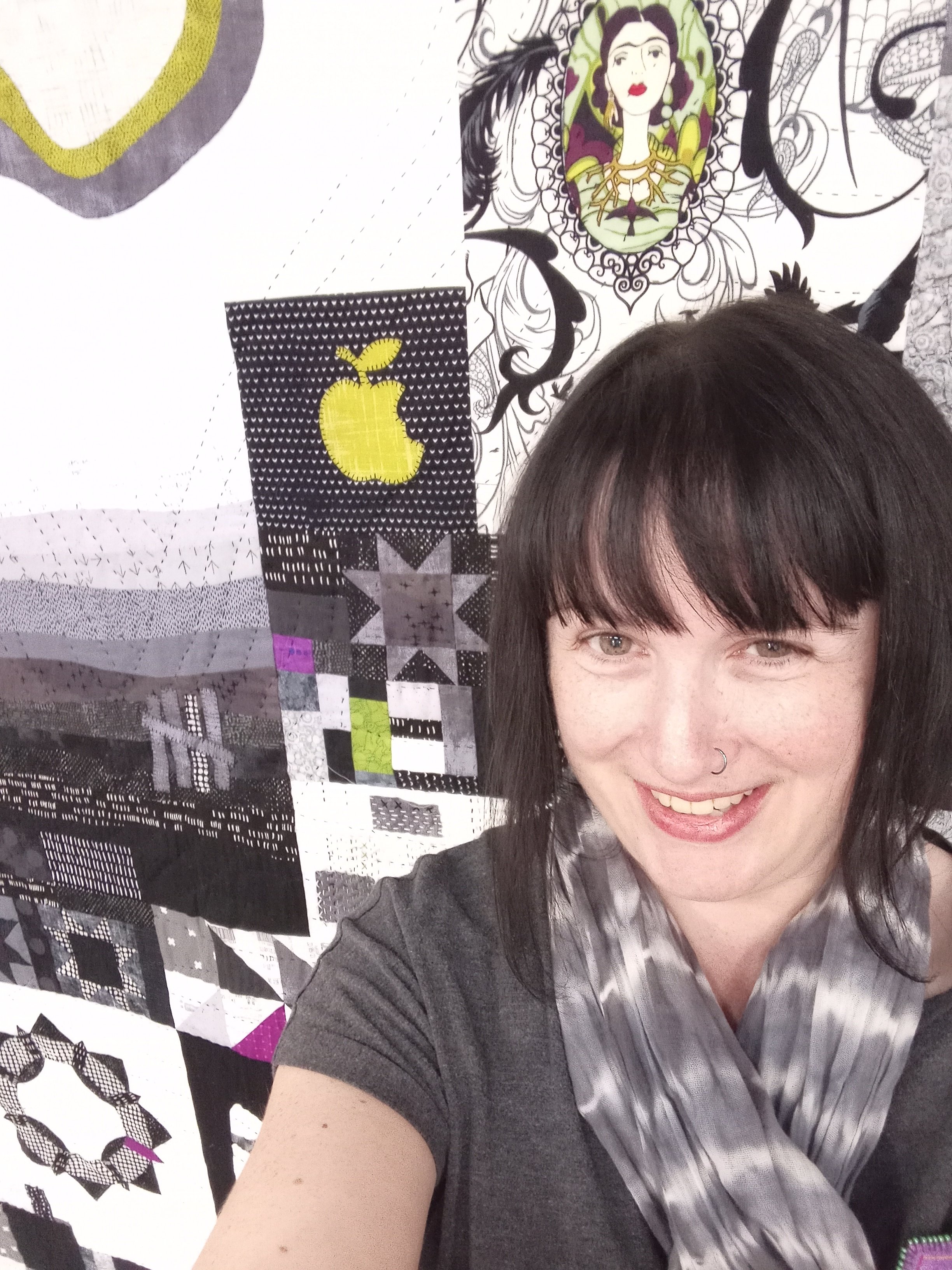Crone
Sarah Humphreys
Crone, quilt, 12.5 x 14 inches
“Life is cyclical. You have to have an ending to have a beginning.”
Interview by L. Valena
September 27, 2023
Can you please start by describing the prompt that you responded to?
It was a photograph. I don't know much about photography, so I don't know the correct terminology, but it was an altered or manipulated photograph. There was a young woman in the center in a pale outfit, and she was eyes closed, head up to the sky, hands open. There were butterflies in the foreground, she looked like she was releasing butterflies or receiving butterflies. The sky was either dawn or dusk behind her. There were lines of aging through the photograph as well.
What were your first thoughts and feelings about that?
As I say, I don't know a lot about photography at all, but it resonated a lot with things that I've been working with recently. I teach arts and crafts to adults, and I'm always telling people to look, like properly look. So my first stage, because it's what I do with my students, is to not have any thoughts, but just to list all the things you can see. I realized as I was writing my list that these images - the butterflies, the young woman - suggested birth, new life, the early stages of womanhood. Whether it was dawn or dusk, I don't know, but it felt like dawn and an awakening. So that was really where I started. And then strong purples and violets in the image as well.
What happened next?
I decided to go with the purple. I'm a textile artist and quiltmaker, and I usually work quite improvisationally, so I drew a load of fabric in shades of purple. I also had some neutrals and some navy blues. I'm at a different stage in my life. I don't know if you know the triple goddess, which is a pagan symbol, representing the maiden, the mother, and the crone. I'm coming toward the crone age [laughs], so it felt like a really interesting contrast with the photograph. My initial thoughts were more dusk, which is why I pulled the navy and blues with my fabric, but in the end I didn't use any of the blue.
I had this heap of fabric, and I literally just cut, no measuring anything, overlapping fabrics, cutting, seeing how they go together. The result was strata through the piece, like a quite abstract landscape. I then pieced some white strips through as well which echoed for me the creasing or aging lines that the maker had put in the photograph. I sat with it for a bit and then quilted it. I included a line of spirals in the quilting. These symbolize infinity, new birth, change, or transformations, which again felt in tune with the butterflies from the image. Then I appliqued the triple goddess symbol with the crone picked out in a stronger color.
Oh, that's beautiful! Is this triple goddess theme something that you think about? Have you worked with it before?
It first came into a quilt that I made during the earlier covid time. It would have been 2021 maybe. Obviously, we all experienced a fairly horrendous couple of years and one of the things that weighed very heavily for me at the time was the experiences of women during that period. We had a very high-profile case here in England, in which a young woman was murdered by a serving police officer. It brought up that discourse that we have continually, “When will violence against women end?” And it doesn't. And there was the Taliban going back into Afghanistan. And more. We were already all struggling at the time, and I was listening to the radio, hearing all these stories from women that felt very hopeless.
So I started a quilt, which was very much about the experiences of women, and the triple goddess came into it. I love the symbol because it reminds us of feminine power, but also that we have roles imposed on us as well as roles that we can choose for ourselves. Typically, the maiden and the mother are what the world wants from us, and the crone is supposed to be toward the end of your life. But really, women spend about half of our life in that stage if we live a reasonable life expectancy, and at this time we have wisdom and freedom in many ways from those expectations. I have this conversation with other female makers about feeling that sense of freedom, that we are moving into that stage of our lives where perhaps society ignores us as older women or middle-aged women. But there’s a power there in some ways because we can make choices without expectations. So yes, I'm really finding more and more that those symbols of feminine power are perhaps not what other people think they should be.
Wow, that’s so cool. Your piece is really a bringing together of youth and newness with this crone archetype. How do these concepts fit together? Do they fit together?
Absolutely! We all go through life, don’t we, with so many anxieties and expectations. Yes, the photo felt very young and about new beginnings. I look at young women today, and I remember myself as an 18-year-old or 25-year-old, and it's terrifying. It's wonderful. It's great fun. You know, the world's your oyster. But it's terrifying.
As a young woman, I gained so much from being a quilt-maker, which I began in my teens, because of spending time with much older women. Quilting is often seen as an older woman's hobby, but I went to a group with women of all ages. They don't sit you down and tell you things, but you learn so much from observing them and being with them. I learned to laugh at anything. When you’re a teenager, you don’t expect a woman who looks like your grandmother to make filthy jokes but they do! I think the beauty and the power of women is that we can learn from one another. I think that women's strength is really wonderful.
In the beginning, you need those older women, but equally, we need the younger women too. We all have so much to offer. Society often wants to set us against each other. You read the papers and they say, “Why Childless Women Hate Women With Children,” and you get so much of this. We all have our own path, and we can enjoy every stage of it. The dawn, the later years—you need to have all of those things. That’s why I included the spirals. Life is cyclical. You have to have an ending to have a beginning. You should relish that, as a woman and as an artist, you have things to offer other people at all stages of life. You have things for yourself as well. As an older woman, I think you realize you don’t have to be everything to everybody. Often a lot of pressure is put on younger women to be everything and it’s exhausting.
That makes sense. That’s a really interesting point. You said that improvisational quilt-making tends to be your process. How does that process look? How does that usually happen?
It's a spectrum really. Often with quilt-making, people think improv is just making it up as you go along, but in all art forms you have to have a lot of experience and knowledge to be able to improvise with confidence and get the outcomes you want. Think of jazz musicians and the like. I'm often working to a structure, whether that's a color palette or a shape, or it could be literally that I've pulled a pile of fabric and wondered, “Where am I going with that today?” But at the other end, I can have a very clear structure, and within that I am stitching the elements and shapes improvisationally, knowing exactly where those shapes will go on my finished piece.
I collect bits on a design wall; it might be one quilt, it might be two quilts. I don't mind sitting with things for a while. Because of the layout of my house, I come into the room where I sew facing this wall each morning, and often from that distance I find myself thinking, “Oh okay, that's working, that's not working.” We all get too close to our work. And I don't mind if things don't go into a quilt because at some point they will appear somewhere. It's like collecting found items. I'll collect bits and see where they go.
You've talked about this a bit already, but how does this piece relate to the rest of your work?
I think of quilt-making as a feminist act. We are honoring work that women (and men, but predominantly women) have done for decades. Recently my work has been getting more and more feminist, and outwardly feminist. It is also becoming more personal. With quilt-making, there are traditions and a lot of information and knowledge that exist already, but marrying a very personal experience with my quilt-making is my current path.
This process was fascinating because I love a challenge. I was so excited when I found out about you folks. I thought, “I'm just going to take what I get and go with it,” but to find so much that I was already thinking about was really wonderful.
That's awesome.
You have so much fun, don’t you, seeing all these things?
Oh! It’s the best! [laughs] Okay, great. Do you have any advice for another artist approaching this project for the first time?
I would say what I say all the time: look. Really look. Before you start to think, look, describe… I write lists and notes, but other people take pictures or sketch. Whatever your process is, take time to look and look again before you jump in to what you want to make. And two weeks is brilliant because it makes you do it, but you still have time to just let the ideas come through.
I'm excited to see what somebody makes from my piece. Do you have many quilt-makers or textile artists?
We do, which is awesome. I feel like it comes in waves.
I've been telling everybody I know about you. I love your definition of an artist: if you create, you’re an artist.
Yeah, if you create, you are definitely welcome to come and join us.
Call Number: M83VA | M85VA.huCro
Sarah Humphreys – modern quilt maker in Yorkshire, UK, on IG as EdwardAndTheWhiteBear. Experienced teacher, passionate about supporting others in their creativity. Unapologetic feminist.








